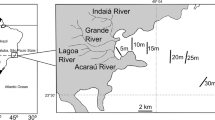Synopsis
The spatial distribution and parental care of demersal egg masses of buffalo sculpin (Enophrys bison) were studied at 11 areas in Puget Sound, Washington, during 1972–1973. Adult buffalo sculpin inhabited rock and rock-sand habitats at depths from the intertidal to minus 20 m throughout the year, but 84% of all spawn clusters were found at depths between −1 m and +1 m within localized rocky areas. Areas used for spawning were exposed to strong tidal currents and other water movements. A single male fish guarded and fanned spawn, but eggs were temporarily deserted when less than about 1 m of water covered the spawning site. The cyclical nature of male desertion, behavior of spawn predators, and spawn mortality due to physical factors while emergent suggest several possible advantages to low intertidal spawning. These advantages include spatial and temporal escape from marine predators by embryos, time for the tending parent to forage, and optimal physical conditions for embryonic development.
Similar content being viewed by others
References cited
Alderdice, D. F., W. P. Wickett & J. R. Brett. 1958. Some effects of temporary exposure to low dissolved oxygen levels on Pacific salmon eggs. J. Fish Res. Board Can. 15: 229–249.
Bagenal, T. B. & E. Braum. 1971. Eggs and early life history. pp. 166–198. In: W. E. Rickerford (ed.) Methods for assessment of fish production in fresh waters, IBP Handbook No. 3, Blackwell, Oxford.
Buckland-Nicks, J., F. S. Chia & S. Behrens. 1973. Oviposition and development of two intertidal snails,Littorina sitkana andLittorina scutulata. Can. J. Zool. 51: 359–365.
Clark, P. J. & F. C. Evans. 1954. Distance to nearest neighbor as a measure of spatial relationships in populations. Ecology 35: 445–453.
Connell, J. H. 1972. Community interactions on marine rocky intertidal shores. Annu. Rev. Ecol. Syst. 3: 169–192.
Dell, M. B. 1968. A new fish tag and rapid cartridge-fed applicator. Trans. Amer. Fish. Soc. 97: 57–59.
DeMartini E. E. 1976. The adaptive significance of territoriality and egg cannibalism in the painted greenling,Oxylebius pictus Gill, a northeastern Pacific marine fish. Ph.D. Thesis, University of Washington.
Ebeling, A. W. & R. N. Bray. 1976. Day versus night activity of reef fishes in a kelp forest off Santa Barbara, California. U.S. Fish. Bull. 74: 703–717.
Edmunds, M. 1974. Defence in animals: a survey of antipredator defences. Longman, Inc., New York. 357 pp.
Feder, H. M., C. H. Turner & C. Limbaugh. 1974. Observations on fishes associated with kelp beds in southern California. Calif. Fish Game, Fish Bull. 160: 1–144.
Gnose, C. E. 1967. The ecology of the striped seaperch,Embiotoca lateralis, in Yacquina Bay, Oregon. Master's Thesis, Oregon State University.
Green, J. M. 1971. Local distributions ofOligocottus maculosus Girard and other tidepool cottids of the west coast of Vancouver Island, Canada. Can. J. Zool. 49: 1111–1128.
Greig-Smith, P. 1964. Quantitative Plant Ecology. Butterworths, London. 256 pp.
Hart, J. L. 1973. Pacific Fishes of Canada. Fish. Res. Board Can. Bull. 180: 1–740.
Hickling, C. F. & E. Rutenberg. 1936. The ovary as an indicator of the spawning period in fishes. J. Mar. Biol. Assoc. U. K. 21: 311–318.
Hubbs, C. L. & A. N. Wick. 1951. Toxicity of the roe of the cabezonScorpaenichthys marmoratus. Calif. Fish Game 37: 195–196.
Hubbs, C. 1966. Fertilization, initiation of cleavage, and developmental temperature tolerance of the cottid fish,Clinocottus analis. Copeia 1966: 29–42.
Jewell, E. D. 1968. SCUBA diving operations on lingcod spawning at a Seattle breakwater. Wash. Dept. Fish., Fish. Res. Pap. 3: 27–34.
Johnson, C. R. 1968. Food of the buffalo sculpin,Enophrys bison. J. Fish. Res. Board Can. 25: 807–812.
Jones, B. C. 1972. The effect of intertidal exposure on survival and embryonic development of Pacific herring spawn. J. Fish. Res. Board Can. 29: 1119–1124.
Lloyd, M. & H. S. Dybas. 1966. The periodical cicada problem. II. Evolution. Evolution 20: 466–505.
Miller, D. J. & J. J. Geibel. 1973. Summary of blue rockfish and lingcod life histories; a reef ecology study; and giant kelp,Macrocystis pyrifera, experiments in Monterey Bay, California. Calif. Fish Game, Fish Bull. 158: 51–77.
Miller, D. J. & R. N. Lea. 1972. Guide to the coastal marine fishes of California. Calif. Fish Game, Fish Bull. 157: 1–235.
Paine, R. T. 1974. Intertidal community structure: experimental studies on the relationship between a dominant competitor and its principal predator. Oecologia (Berlin) 15: 93–120.
Patterson, I. J. 1965. Timing and spacing of broods in the blackheaded gullLarus ridibundus. Ibis 107: 433–459.
Pillsbury, R. W. 1957. Avoidance of poisonous eggs of the marine fishScorpaenichthys marmoratus by predators. Copeia 1957: 251–252.
Qasim, S. Z. 1956. Time and duration of the spawning season in some marine teleosts in relation to their distribution. J. Cons., Cons. Int. Explor. Mer 21: 141–155.
Sandercock, F. K. & N. J. Wilimovsky. 1968. Revision of the cottid genusEnophrys. Copeia 1968: 832–853.
Siegel, S. 1956. Nonparametric Statistics for the Behavioral Sciences. McGraw-Hill, New York. 312 pp.
Stevenson, J. C. 1949. The extent of herring spawning in British Columbia in 1949. Fish. Res. Board Can., Prog. Rep. Pac. Coast Sta. 80: 57–59.
Taylor, F. H. C. 1971. Variation in hatching success in Pacific herring (Clupea pallasii) eggs with water depth, temperature, salinity and egg mass thickness. Rapp. P.-V. Reun., Cons. Int. Explor. Mer 160: 34–41.
Westin, L. 1968. Environmentally determined variation in the roe colour in the fourhorn sculpinMyoxocephalus quadricornis (L.). Oikos 19: 403–407.
Wilbur, H. M. & J. P. Collins. 1973. Ecological aspects of amphibian metamorphosis. Science 182: 1305–1314.
Wilby, G. V. 1937. The lingcod,Ophiodon elongatus Girard. Biol. Board Can. Bull. 54: 1–24.
Author information
Authors and Affiliations
Rights and permissions
About this article
Cite this article
DeMartini, E.E. Spatial aspects of reproduction in buffalo sculpin,Enophrys hison . Environ Biol Fish 3, 331–336 (1978). https://doi.org/10.1007/BF00000524
Received:
Accepted:
Issue Date:
DOI: https://doi.org/10.1007/BF00000524




